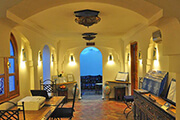Asilah Travel Guide
The soul of this city, counting 25,000 inhabitants, is still intact. It is the rendezvous point of women coming down from the Rif to sell their products at the market, wearing a fouta on their waist and a big colorful pomponned hat on their head; donkeys roam the medina, instead of Marrakesh and Essaouira's noisy mopeds. The fact that the previous Minister of Culture is originally from Asilah means a lot... He has built a very pleasant city.
Transportation
Buses
The bus station is located a few meters away from the city center (on the avenue of the crown Prince, Sidi-Mohamed). Asilah is situated on a privileged bus line and buses going to Tangier and Rabat are not lacking. On the bus line in the direction of Tangier (40 minutes and 15 MAD) and of Larache, buses leave continuously.
By Train
The city is well connected by train, it takes 3 hours from Rabat and only 30 minutes from Tangier.
Where to Stay in Asilah
History
According to some researchers, the history of Asilah goes back more than 3,600 years. The name of this city, previously called “Zilis”, is mentioned by many authors and ancient historians.
In accordance with these same documents, Zilis was one of the biggest Carthaginian agglomeration during the era of Tingitane Mauritania. It has been successively occupied by Phoenicians, Carthaginians, Byzantines, Romans and Portuguese. After the islamisation of the country, this city, named then Asilah, has been reconstructed in 844 on a land belonging to the El-Ouata tribe, governed by El-Kacem ben Driss Chafi. Since that time, and given its importance on a strategic level, this little village has been the object of bloody conflicts between Cordoba's Maronides and Africa's Abidiyines.
After the decadence of his dynasty, the last Idrisid standing took refuge there. In 1265, the city has been destructed to prevent the Spanish from taking it after the defeat of the Moroccan army. Starting from 1415, Asilah is going from hand to hand, taken by the Moroccan army and the Portuguese army; this fight was marked by the famous battle of Oued El-Makhazine. The city was ultimately recovered by the king Moulay Ismail, in 1691.
At the beginning of that century, the city could not resist the Spanish invasion, despite the resistance and sacrifices of its inhabitants, especially the ones made by the leader Ahmed Raissouni, in 1906. The history of Asilah is not only about wars and conquests, it is also about culture and fine arts. Lastly, the king Mohammed V has honored the city with his visit during his historical journey to Tangier on April 9th, 1947.

Places to visit
The medina of Asilah small and an authentic, it is accessible only by foot, you will find there many paintings by local artists and other souvenirs shops.
Share your experiences with our community.
Join our Mailing List and receive electronic invitations and news about cultural events in Morocco.
Advertisement
Advertisement


